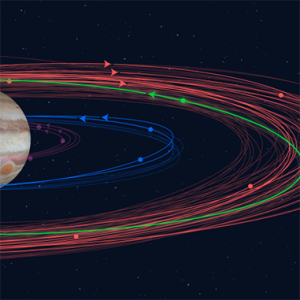Video: Carnegie Science

Scientists announced the discovery of 12 new moons orbiting the planet Jupiter, including one that bucks the trend by orbiting in the opposite direction from others of its kind.
Two astronomers from the University of Hawaiʻi Institute for Astronomy, provided crucial observations. Dave Tholen and Dora Fohring, were using the UH 88-inch telescope and the Subaru telescope on Maunakea to search for the recently theorized Planet X. This unknown massive planet at the fringes of the Solar System, far beyond Pluto, could explain the similarity of the orbits of several small extremely distant objects.
By sheer coincidence, Jupiter and its newly found moons were in the same area as the survey fields for Planet X. Confirming that the newly found objects are truly moons of Jupiter, and not objects just orbiting the Sun, requires multiple observations to pin down their motions, and this usually takes a year. But astronomers can’t wait a year to make the follow-up observations, because the objects become lost or difficult to properly associate with the same object, so it’s necessary to track the candidate moons multiple times over the course of a year.
Tholen and Fohring’s observations allowed the team to follow the motions of the possible moons and refine the orbits of these satellites. Even though these are objects in our own solar system, the observations were challenging. When these moons were visible, Jupiter was very close to our own bright moon, so great care was needed to ensure that the images didn’t saturate from overexposure. The moons are so faint that they are not actually visible on any single exposure, only when several images are combined.
Read more at Carnegie Science.

